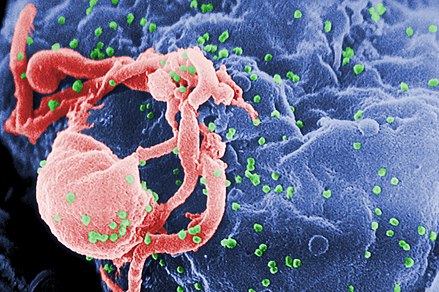Bugchasing
Bugchasing (alternatively bug chasing[1]) is the rare practice of intentionally seeking human immunodeficiency virus (HIV) infection through sexual activity.[2]
Bugchasers—those who eroticize HIV—constitute a subculture of barebackers, men who have unprotected sex with other men. It is exceedingly uncommon for men to self-identify as bugchasers, but among those who do, their behavior does not consistently match this identification; instead, they often seek ambiguous sexual situations, rather than ones in which their partner is known to have HIV. There are some explanations for the behavior, ranging from sexual excitement at the idea of HIV-positive status, to finding a shared sense of community with other HIV-positive people, to suicidality.[3]
By 2003, the concept had entered the public consciousness after Rolling Stone published "Bug Chasers: The men who long to be HIV+", an article describing the practice. It may have existed since the AIDS crisis began. It has since been mentioned in or the focus of pieces of media and popular culture. As of 2021[update], bugchasing behavior still persists as a niche behavior, in spite of the widespread availability of effective PrEP and HAART treatments that protect against HIV transmission in otherwise unprotected sex.
The precise origins of bugchasing—the pursuit of HIV infection—are largely unknown, with its inception located either at the beginning of the AIDS crisis or closer to the 1990s.[4] But it existed by at least 1997, when Newsweek published an article about the subject,[5] followed by Rolling Stone in 2003. The Rolling Stone article, "Bug Chasers: The men who long to be HIV+", was the first to bring widespread concern and attention to the practice.[6] That article claimed that around 25 percent of all new HIV infections in the United States (10,000 of 45,000) were linked to bugchasing activity.[6]Freeman's analysis, however, did not only count bugchasers: it included all men who engaged in barebacking, regardless of motivation or attempts to seek out HIV infection, reporting them all together as bugchasers.[7] Authorities that Freeman cited have since claimed he fabricated their statements, and his data have been widely criticized.[8] Even so, Freeman's article was arguably responsible for bringing the term bugchasing to the mainstream,[9]viewing bugchasing as both self-destructive and pitiful.[10]
Bugchasers are men who have sex with men (MSM) who eroticize HIV infection, especially through the intentional pursuit (or intended pursuit) of infection with the virus.[11] Since little is understood about the practice in general, the motivations for developing bugchasing identity and behavior remain largely undefined.[12] However, there are four common motivating explanations.[13]
Once the initial shock dissipated, he felt relieved, like he had been given a free pass to have consensual bareback sex without worry of being infected.

